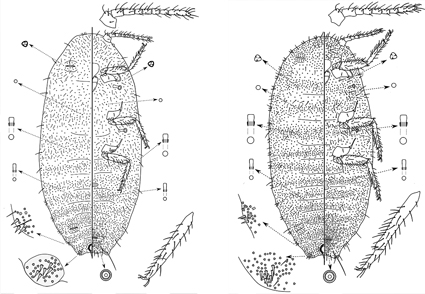Abstract
The taxonomic status of some mealybug species (Hemiptera: Coccomorpha: Pseudococcidae) found on dwarf bamboos in Japan are reviewed. A species currently placed as a junior synonym of Paraputo angustus (Ezzat & McConnell 1956) was found to differ from P. angustus by having dorsal oral collar tubular ducts of two sizes rather than one, so it is revived as Formicococcus bambusiphilus (Takahashi 1958) stat. rev. and comb. nov.; it is redescribed, based on the lectotype and a paralectotype designated in this study and additional adult females collected more recently. A new species, Formicococcus kawaii sp. nov., is described; it is similar to F. bambusiphilus and Paraputo angustus (Ezzat & McConnell 1956) but differs from them in having 18 pairs of cerarii, relatively large antennae and hind legs, and a dumbbell-shaped circulus. The characterization of a third dwarf bamboo-feeding species, Paraputo kaiensis (Kanda 1932), is updated based on adult females collected by the original describer and material collected more recently. Paraputo kaiensis resembles P. pauper (Danzig 1971) but differs in lacking translucent pores on the hind legs and in possessing a circulus. It also differs from most species of Paraputo Laing by having the anal opening situated on the posterior margin of the dorsum and an elongate-oval body, so the generic placement of this species remains questionable. Identification keys to separate mealybug genera with anal lobe bars and without oral rim ducts found in Asia, and to species of adult female Formicococcus in Japan and Paraputo in East Asia are provided.
References
Ali, S.M. (1967) Description of a new and records of some known coccids (Homoptera) from Bihar, India. Oriental Insects, New Delhi, 1, 29–43. https://doi.org/10.1080/00305316.1967.10433849
Ben-Dov, Y. (1999) A note on Ferrisicoccus Ezzat & McConnell (Hem., Coccoidea, Pseudococcidae). Bulletin de la Société entomologique de France, 104 (4), 380. https://doi.org/10.3406/bsef.1999.16599
Borchsenius, N.S. (1960) [Coccid fauna of China. 9. New soft scales of the families Margarodidae, Eriococcidae and Pseudococcidae (Homoptera, Coccoidea)]. Entomologicheskoe Obozrenye, 39, 914–938. [in Russian]
Borchsenius, N.S. (1962) [Notes on the Coccoidea of China. 11. New genera and species of mealybugs fam. Pseudococcidae (Homoptera, Coccoidea).] Trudy Zoologicheskogo Instituta Akademiya Nauk SSSR. Leningrad, 30, 221–244. [in Russian]
Cockerell, T.D.A. (1896) Notes and descriptions of the new Coccidae collected in Mexico by Prof. C.H.T. Townsend. Bulletin, United States Department of Agriculture, Division of Entomology, Technical Series, 4, 31–39.
Danzig, E.M. (1971) New and little-known species of mealy-bugs (Homoptera, Coccoidea, Pseudococcidae) from the Far East of USSR. Entomologicheskoe Obozrenye, 50, 366–391.
Danzig, E.M. (1978) Scale insect fauna of South Sakhalin and Kunashir. Trudy Biologo-Pochvennogo, Akademii Nauk SSR, Vladivostok, 50, 3–23.
Danzig, E.M. (1980) [Coccoids of the Far East USSR (Homoptera, Coccinea) with phylogenetic analysis of scale insect fauna of the world]. Nauka, Leningrad, 367 pp. [in Russian]
Danzig, E.M. & Gavrilov-Zimin, I.A. (2015) Palaearctic mealybugs (Homoptera: Coccinea: Pseudococcidae), Part 2: Subfamily Pseudococcinae. Russian Academy of Sciences, Zoological Institute, St. Petersburg, 619 pp.
Ezzat, Y.M. & McConnell, H.S. (1956) A classification of the mealybug tribe Planococcini (Pseudococcidae: Homoptera). Bulletin of the Maryland Agriculture Experiment Station, A-e84, 1–108.
Ferris, G.F. (1950) Atlas of the Scale Insects of North America. Series 5. Vol. 5. The Pseudococcidae. Part I. Stanford University Press, Palo Alto, California, 278 pp.
Ferris, G.F. (1955) On some genera of the Pseudococcidae. (Homoptera: Coccoidea). (Contribution No. 90). Microentomology, 20, 1–19.
García Morales, M., Denno, B.D., Miller, D.R., Miller, G.L., Ben-Dov, Y. & Hardy, N.B. (2016) ScaleNet: a literature-based model of scale insect biology and systematics. Database. Available from: http://scalenet.info (accessed 18 May 2022)
Green, E.E. (1923) Observations on British Coccidae.—VIII. Entomologist’s Monthly Magazine, 59, 211–218.
Kanda, S. (1932) A new species of the genus Pseudococcus. Annotationes Zoologicae Japonenses. Tokyo, 13, 387–390.
Kawai, S. (1972) Diagnostic notes and biology of the coccid species occurring on cultivated or wild trees and shrubs in Japan (Homoptera: Coccoidea). Bulletin of the Tokyo-To Agricultural Experiment Station, 6, 1–54. [in Japanese]
Kawai, S. (1980) Scale Insects of Japan in Colors. Zenkoku Nôson Kyôiku Kyôkai, Tokyo, 455 pp. [in Japanese]
Laing, F. (1929) Descriptions of new, and some notes on old species of Coccidae. Annals and Magazine of Natural History, 4, 465–501. https://doi.org/10.1080/00222932908673084
Li, W.C., Tsai, T. & Wu, S.A. (2014) A review of the legged mealybugs on bamboo (Hemiptera: Coccoidea: Pseudococcidae) occurring in China. Zootaxa, 3900 (3), 370–398. https://doi.org/10.11646/zootaxa.3900.3.3
Newstead, R. (1908) 12. Hemiptera. 1. Coccidae. [Scientific results of the Swedish zoological expedition to Mount Kilimanjaro, Mount Meru and the surrounding Maasai steppes of German East Africa 1905–1906]. Almquist & Wiksells, Uppsala, 10 pp.
Takahashi, R. (1928) Coccidae of Formosa (2). Transactions of the Natural History Society of Formosa. Taihoku, 18, 253–261.
Takahashi, R. (1958) Key to the genera of Pseudococcidae in Japan, with descriptions of three new genera and two new species. Bulletin of the Osaka (Perfecture) University, 7 (1957), 1–8.
Tanaka, H. & Kamitani, S. (2021) Two new species of Coccomorpha (Hemiptera: Sternorrhyncha) collected from Japanese silver grass, Miscanthus sinensis (Poaceae) in Okinawa Island, Japan. Zootaxa, 4941 (4), 569–579. https://doi.org/10.11646/zootaxa.4941.4.6
Tanaka, H., Suetsugu, K. & Kamitani, S. (2021) A parasitic insect on a parasitic plant: a new species of the genus Formicoccus Takahashi (Hemiptera, Coccomorpha, Pseudococcidae) from Ishigaki Island, Japan. ZooKeys, 1060, 171–182. https://doi.org/10.3897/zookeys.1060.71652
Uchimura, E, (2005) [A Pictorial Book of Bamboo and Dwarf Bamboo, -Species, Diagnosis, and Uses -]. Soshinsha, Tokyo, 219 pp. [in Japanese]
Wang, T.C. (1978) [A new coccid of Paraputo (Homoptera: Coccoidea)]. Acta Entomologica Sinica, 21, 415–416. [in Chinese with English summary]
Wang, T.C. (1982) [A study on the Chinese Paraputo and Heliococcus with description of new species (Homoptera: Coccoidea: Pseudococcidae)]. Acta Entomologica Sinica, 25, 315–320. [in Chinese with English summary]
Williams, D.J. (2004) Mealybugs of southern Asia. The Natural History Museum, London. Southdene SDN and BHD, Kuala Lumpur, 896 pp.
Zhang, J.T. & Wu, S.A. (2017) A study of the genus Paraputo Laing, 1929 of China, with description of two new species (Hemiptera, Sternorrhyncha, Coccomorpha). ZooKeys, 709, 57–70. https://doi.org/10.3897/zookeys.709.15161


